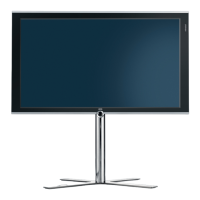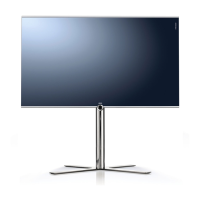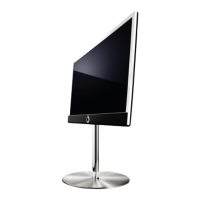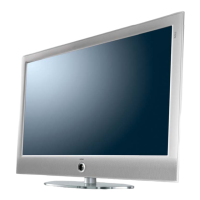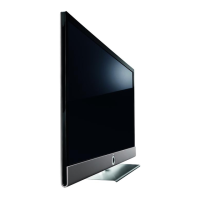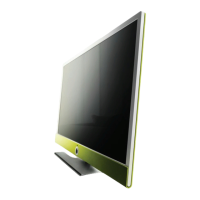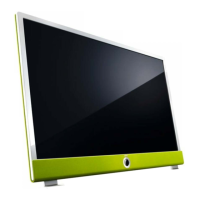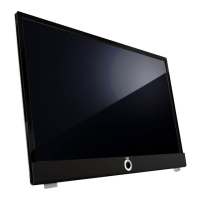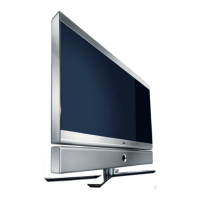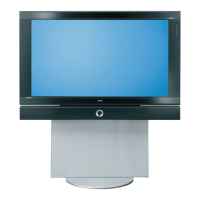
Do you have a question about the Loewe Individual 40 Selection and is the answer not in the manual?
Controls power, standby, and mode switching between TV, Radio, and DVD.
Enables direct station entry, list navigation, and channel up/down selection.
Accesses main menus, EPG, Teletext, index, and status displays for system information.
Manages picture format, PIP settings, and utilizes special function keys for quick access.
Visual indicators for the TV set's operating status and mode.
Physical buttons on the unit for menu navigation, station selection, and power.
Indicator for the status of the integrated Digital Recorder.
Ports on the side for common interface, audio, and video input.
Comprehensive list of input/output sockets on the back of the TV for various devices.
Highlights key features like HDTV and HDMI for high-quality viewing.
Lists all items included in the TV set packaging.
Guidance on safe transport and various mounting/placement options.
Information on LCD screen care, pixel defects, and cleaning procedures.
Guidelines for environmentally friendly disposal and packaging retention.
Instructions for safely removing protective film from the screen.
Essential safety instructions for TV operation, environment, and power.
Guidelines on TV placement, ventilation, electrical safety, and user precautions.
Inserting batteries, disposal, and initial setup of the remote control.
Connecting the power supply and the antenna system for TV reception.
Optional accessories for tidy cable management.
Inserting a CA module and Smart Card for encrypted channels.
Procedure for turning the TV on for the first time.
Guides through the initial search and storage of TV and radio stations.
How to change the order of stored stations.
Using signal quality indicators to optimize DVB-T antenna positioning.
Instructions for switching the TV and Radio on, off, and to standby mode.
How to change channels using remote control buttons, including direct entry.
Quickly switch back and forth between the two most recently viewed stations.
Using the on-screen station list to select and change channels.
Understanding how to navigate and interact with TV menus.
Adjusting volume, muting, bass, treble, and managing sound on/off functions.
Utilizing context-sensitive info texts within menus for guidance.
How to use the index to find functions and information.
Adjusting volume, muting, bass, treble, and applying sound effects.
Adjusting picture parameters and using direct controls for TV operation.
Explains the functions of the coloured buttons specific to TV mode.
Displaying current programme information and accessing the system index.
Accessing special functions like Image+, Teletext subtitles, and scan stations.
Managing timer recordings and adjusting picture format and position.
Connecting external equipment via wizard, antenna, and digital link.
Searching, storing, rearranging, and naming TV stations.
Setting parental locks and programming timer functions for recording or wake-up.
Configuring language, on-screen displays, time/date, and DVB subtitle preferences.
Procedures for inserting, removing, and accessing information for the CA module.
Managing and updating the TV's DVB software for optimal performance.
Description of the Image+ picture enhancement technology.
How to use the demo mode to compare Image+ effects.
Introduction to the Picture-in-Picture (PIP) functionality and its requirements.
Controlling PIP channel selection, freezing, scanning, and swapping main/PIP views.
Overview of settings available within the PIP menu.
Customizing PIP type (small, split) and adjusting its screen position.
Explanation of the EPG system for programme information and recording.
How to switch EPG on/off and navigate through programme listings.
How to mark programmes for recording using the EPG.
Managing EPG settings, providers, data capture, and auto-on features.
Introduction to analogue Teletext and how to activate/deactivate it.
Methods for navigating Teletext, selecting pages, and controlling display.
How to set up timer recordings for video/DVD recorders using Teletext.
Operation and features of digital teletext (MHEG-5) including menu navigation.
How to switch the radio on, off, and basic operation.
Accessing radio settings and programme guide information.
Using the wizard to connect and configure external devices.
Specific steps for connecting VCRs/DVD recorders and auto-tuning stations.
Different methods to view video sources like VCR, DVD, and camcorders.
Setting timer recordings using the TV for connected video or DVD recorders.
Connecting external digital audio sources to the TV's digital input.
Outputting digital audio signals from the TV to external amplifiers.
Steps to connect the Loewe DVD Preceiver and Auro sound system for cinema quality audio.
Connecting stereo, surround, or digital amplifiers and active speakers for audio output.
Connecting digital video and audio sources via HDMI for high definition.
Connecting PCs or Set Top Boxes, adjusting geometry and colour standards.
Feeding analogue or digital audio signals from PCs or STBs to the TV.
Connecting video sources via component inputs for higher quality playback.
Using the remote control to operate Loewe DVD players and recorders.
Configuring the remote for different devices and switching back to TV control.
Using the remote control to rotate the TV set for optimal viewing angles.
Adjusting rotation limits and setting the TV's auto-off position.
Solutions for issues related to the recording menu, connections, and external recorder control.
Troubleshooting steps for AV input issues and faulty decoder connections.
How to correct the menu language if it has been set incorrectly.
Solutions for problems with Digital Link Plus and incorrect teletext character display.
Troubleshooting no sound with digital amplifiers and issues with motorized rotation.
Guidance on cleaning the front screen, noting it requires dealer intervention.
Comparison of technical specifications across different TV models and versions.
Details on chassis, power supply, tuner, standards, and audio output.
Comprehensive list of all input/output sockets and their specifications.
Various options for mounting the TV on walls or stands.
Accessories for enhancing TV reception and compatibility with VESA mounts.
Accessories for system integration, aesthetic customization, and media storage.
Table detailing available retrofitting options for different device versions.
